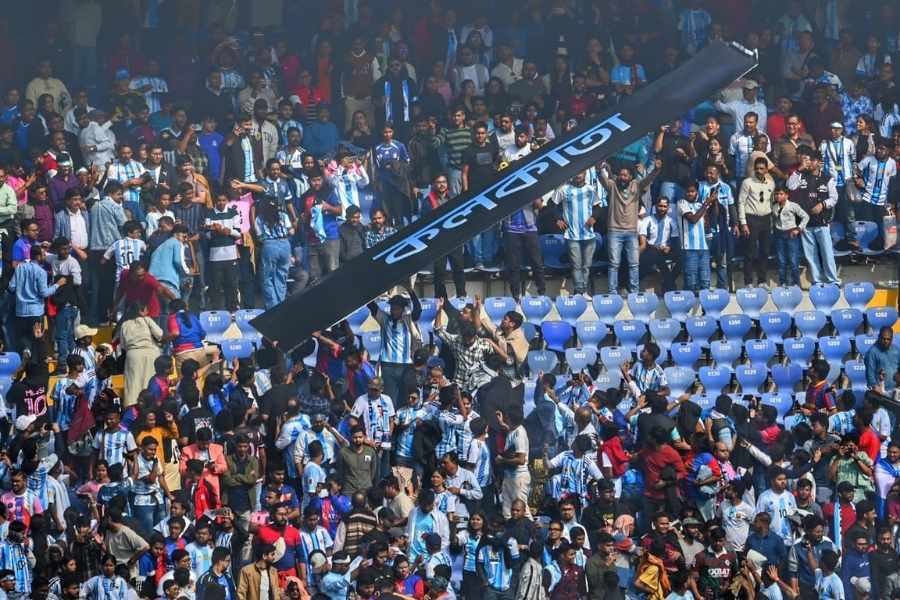
Live Orchestra, says the signboard outside a nondescript building. That's the signal for those looking for a dance bar in Mumbai. A live orchestra, in most restaurants, translates into a band with perhaps a female crooner. Here, it means gyrating women - or bar girls, as the dancers are known.
The signboards can be seen on Palaspe Road in Panvel, Navi Mumbai, an hour's drive from Mumbai. The area doesn't fall in the city municipal zone, which explains why there are many more beer bars than in the city.
One such bar - run by a Shetty (the community that owns most such bars in Mumbai and its suburbs) - is spilling over with people. Hefty bouncers outside know whom to keep out, and whom to allow in. Patrons are asked to switch off their phones and eagle eyes watch out for the slightest of deviations. The men hold their drinks and watch the women dance.
There are three floors - each floor catering to a different class of customers. One floor is for those who may not have too much money to splurge. Some are farmers who have sold their farmlands to builders for astronomical sums. Here, the dance girls are mostly Bangladeshis. They are very young - barely 17 or 18 - and simply shake their hips and bosoms to music.
The next tier is the VIP - very important person - level. Here the girls are prettier. But those on the VVIP - very very important person - floor have peaches and cream complexions, and show a lot of skin. Most of them wear chaniya cholis - backless blouses - though some are in shorts. The women wear their hair long, and swing as they gyrate to Laila teri le legi. The patrons are mostly politicians, builders and other businessmen.
The men shower the women with money. Waiters in waistcoats discreetly collect the notes and move away. Sixty per cent of the showered money goes to the bar owner, the rest to the girls. The night is long in beer bars and often the lights are put out and the girls hustled into some deep cavity in a wall when the police raid a bar.
Despite bans and rules, beer bars are functioning in Maharashtra, though mostly illegally. Bribes are paid to the police to keep the bars going. Some bars in the city have gone underground. Outside the city limits, many function as usual.
"Rules are just an excuse to extort money," says a beer bar owner who does not want to be named.
Mumbai's beer bars are seldom out of the news. Once called the Las Vegas of the East, the bars did roaring business in the 90s and the first half of the next decade. Then, in 2005, a short-statured politician who was the home minister of Maharashtra, decided that it was a monster's head that needed to be sliced off.
R.R. Patil died in 2015, but not before dismantling beer bars and their contingent of 75,000 dancers. Many of the women went into mujra dancing - doing special shows for the rich, some went away to Dubai, or to other cities. And a few took to prostitution.
For the girls who lost their livelihood, life has not been the same again. A former beer bar dancer says that she has to look after her two young daughters. To educate one daughter, she has asked the other to work as a compounder with a local physician. The mother scours for work at night. She is older now, so it's not easy to find a spot in a bar anymore.
Now, more than 10 years after the ban, efforts are on to revive beer bars and give the dancers the floor. In 2013, the Supreme Court upheld the right of women bar dancers to follow their profession and dismissed the government's appeal to ban them. In October last year, it directed the state government to grant licences to bar owners.
"It is better to dance than to go to streets for begging or earning livelihood through unacceptable means," the court said last month. "This is 2016. Dancing is an established profession. But if it becomes obscene, then it does not have legal sanctity."
Bar girls have been a part of the subculture of Maharashtra, especially Mumbai. Before minister Patil got agitated, bars would have some 40 dancing women. Most of the dancers in south Mumbai were from Congress House, where the erstwhile mujrewalis lived. Some of the girls were trained in Kathak and other forms of dance. They drank pomegranate and sweet lime juice through the night, and whirled to Bollywood numbers.
Old timers recall that beauteous Sweety had a great fan following. It was only when she opened her mouth to speak did one realise that she was a man. A few attractive women, the whisper went, were transvestites.
The beer bars did roaring business. Money flowed in for the girls were showered with money. Alcohol bills were the bonus. Most women would earn around Rs 25,000 a month at the bars; the best looking ones who danced seductively earned Rs 5-7 lakh a month. The police were happy, too - for they got their share of the booty. "But we also got a lot of our information from criminals who would be at the beer bars," a police officer says.
And then Patil ordered a closure. No one knows for sure what prompted him to do so. Some owners alleged that a backdoor financial deal went wrong, irking the minister. Whatever the reason, the bars were shut down. Then, three years ago, the Supreme Court stepped in, speaking on behalf of the dancers.
Recently, after the Supreme Court pulled up the state government, eight licences for dance beer bars were issued. But the Maharashtra government has also put into effect a slew of rules.
For the Maharashtra government, clearly, the bars are a bugbear. They ordered that beer bars should have CCTVs, which should be connected to the local police station. The dance bar owners went to court on this, and it was decided that CCTVs would be posted at the entrance and exit points, but not inside the bar.
The state government has put in other riders: No dance beer bars can function near religious places. Also, it was decreed that dancing couldn't happen in the permit room, where alcohol is served - but only in the dining area.
"If that is the case, why not allow Udupi eateries in Mumbai to have dance performances," says Manjeet Singh Sethi, a former president of the Beer Bar Owners' Association.
The government's decision to have a five-foot gap between patrons and the dancers (a violation could lead to six months in jail or Rs 50,000 as fine) has not gone down well with either patrons or dancers. "Who is to decide whether somebody accidentally brushed against a girl or did so deliberately," asks Varsha Kale, president of the Indian Bar Girls' Association.
Despite the plethora of rules, nothing much is going to change, predicts Shailesh Tawte, a television journalist who has been researching dance beer bars for 10 years. "The show will go on," he says.










